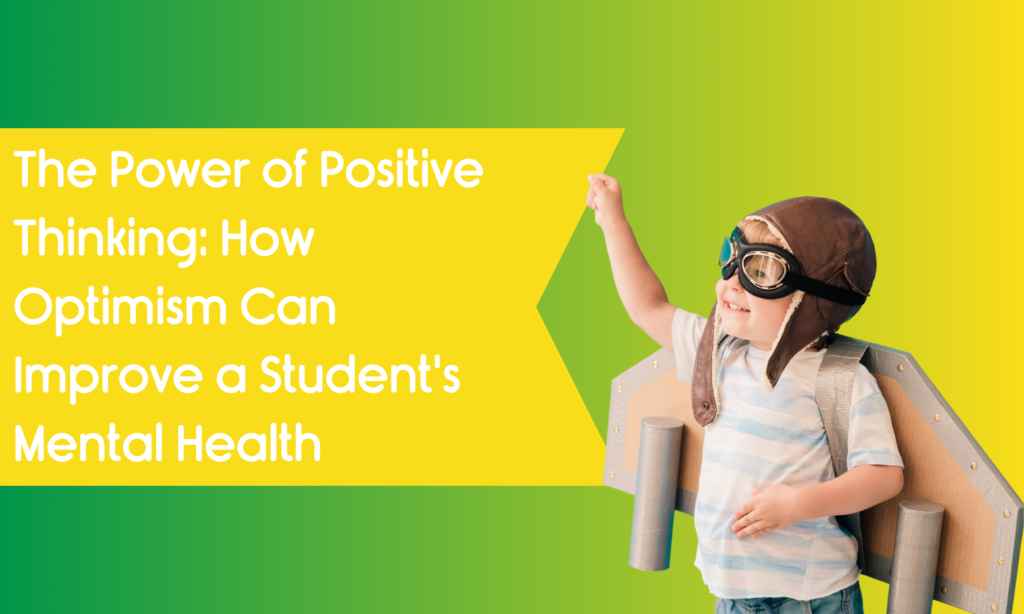The Power of Positive Thinking: How Optimism Can Improve a Student's Mental Health

In the hustle and bustle of school life, students often face a variety of challenges that can impact their mental health. From academic pressures to social dynamics, the school environment can sometimes feel overwhelming. However, one powerful tool that can significantly enhance a student’s well-being is positive thinking. Optimism is more than just a cheerful outlook; it’s a mindset that can transform how students perceive and tackle their daily hurdles. The purpose of this blog is to explore the power of positive thinking and how it can improve the mental health of students.
The Science Behind Positive Thinking
Positive thinking is not just a feel-good concept; it has a strong foundation in science. Studies have shown that optimistic individuals are more resilient, better at coping with stress, and generally healthier. This is because positive thinking can lead to better mental habits, reducing the risk of anxiety and depression. For students, cultivating an optimistic mindset can make a significant difference in their overall mental health and academic performance.
Benefits of Positive Thinking for Students
- Improved Academic Performance
– Optimistic students are more likely to persevere through challenges and setbacks, viewing them as opportunities to learn rather than difficult obstacles. This attitude can lead to improved grades and a more fulfilling academic experience.
- Enhanced Emotional Well-being
– Positive thinking helps students manage stress and negative emotions more effectively. When students focus on the good in their lives and maintain a hopeful outlook, they are less likely to succumb to feelings of anxiety and depression.
- Better Relationships
– Optimism can improve social interactions, making it easier for students to form and maintain healthy relationships. Positive thinkers are generally more approachable and supportive, qualities that foster strong friendships.
- Increased Motivation and Engagement
– Students who practice positive thinking are often more motivated and engaged in their studies and extracurricular activities. This increased enthusiasm can lead to greater participation in school events, clubs, and other enriching experiences.
How to Foster Positive Thinking in Students
Creating an environment that nurtures positive thinking involves both home and school efforts. Here are some strategies to help students develop an optimistic mindset:
Encourage Extracurricular Activities
Participation in extracurricular activities for kids is a great way to foster positive thinking. Whether it’s sports, arts, music, or debate clubs, these activities provide students with opportunities to discover and develop their passions. Engaging in activities they enjoy can boost their self-esteem and provide a healthy outlet for stress.
Implement Play-Based Learning Activities
Incorporating play-based learning activities into the curriculum can make learning more enjoyable and less stressful. This approach encourages creativity and problem-solving skills in a relaxed and fun environment. When students associate learning with positive experiences, they are more likely to develop a lifelong love of learning and an optimistic outlook.
Utilize the Modern School Library
A modern school library is not just a place for books; it’s a hub for inspiration and discovery. Encouraging students to spend time in the library can foster a love for reading and exploration. Libraries often host events, book clubs, and other activities that can help students find joy in learning and broaden their horizons. This exposure to diverse perspectives and knowledge can greatly contribute to a positive mindset.
Practical Tips for Students to Develop Positive Thinking
- Practice Gratitude
– Encourage students to keep a gratitude journal where they can write down things they are thankful for each day. This simple practice can shift their focus from what is going wrong to what is going right.
- Set Realistic Goals
– Help students set possible goals and celebrate their achievements. This can build their confidence and encourage them to keep striving towards their aspirations.
- Surround Themselves with Positivity
– Encourage students to spend time with positive peers and mentors. Positive influences can inspire and uplift them, reinforcing their optimistic mindset.
- Mindfulness and Meditation
– Introducing mindfulness and meditation practices can help students stay present and reduce anxiety. These practices promote a calm and focused mind, which is necessary for positive thinking.
- Positive Self-Talk
– Guide students to replace negative self-talk with positive assertions. Reminding themselves of their strengths and capabilities can boost their self-esteem and strength.
Role of Teachers and Parents
Teachers and parents play a crucial role in encouraging positive thinking in students. By modeling optimistic behavior and providing support, they can create a nurturing environment that encourages students to adopt a positive mindset.
Teachers
- Encourage a Growth Mindset
– Promote the idea that abilities can be developed through hard work and dedication. This helps students view challenges as opportunities to grow rather than as failures.
- Create a Supportive Classroom Environment
– Promote a classroom culture where blunders are seen as learning opportunities. Praise hard work and progress, not just results.
Parents
- Be a Positive Role Model
– Demonstrate positive thinking in your own life. Children often mimic the behavior of their parents, so showing optimism can inspire them to do the same.
- Provide Emotional Support
– Listen to your child’s concerns and encourage them to express their feelings. Offering reassurance and guidance can help them navigate their emotions and maintain a positive outlook.
Conclusion
The power of positive thinking cannot be underestimated when it comes to improving a student’s mental health. By encouraging optimism through extracurricular activities for kids, play-based learning activities, and utilizing the modern school library, we can create an environment that supports and enhances their well-being. With the combined efforts of teachers, parents, and the students themselves, we can help nurture a generation of optimistic, strong, and mentally healthy individuals.

